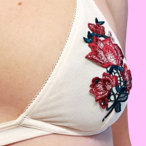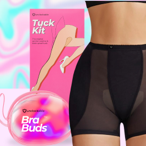
Feminizing Hair Tips for Trans Women
Feminizing Hair Tips for Trans Women
Update: Summer 2025 Haircare & Styling Tips for Heat and Humidity
For Summer 2025, it’s essential to keep your hairstyle fresh and manageable despite the heat and humidity. Opt for lightweight, non-comedogenic products that maintain your style without clogging pores or melting into your clothing. Water-based styling products are especially effective—they’re less likely to cause breakouts along the hairline and neck, which can become problem areas in the summer.
Keep Hair off the Neck to Beat the Heat
To combat the effects of sweat and heat, consider styles that lift hair off the neck, such as updos, high ponytails, or buns. These not only keep you cooler but also reduce the risk of product transfer onto skin and clothing.
Wearing a Wig? Try a Short Bob
If you wear a wig, summer is the perfect time to switch things up. A short bob that clears the neck can be a total game-changer in hot, humid weather. It allows air to circulate more freely, reduces sweat buildup at the nape, and requires less daily maintenance. Look for lightweight cap constructions and breathable linings to maximize comfort. Bonus: short styles dry faster after washing and stay neater throughout the day.
Product Picks That Work in the Heat
When choosing hair care products, always check for the non-comedogenic label. These formulas are designed to avoid blocking pores—especially important in warmer months when skin is more prone to breakouts.
Apply styling products sparingly at the roots to prevent greasiness, and refresh your look with a light spritz of dry shampoo to absorb oil and boost volume.
Stay Ready with On-the-Go Tools
Keep a brush-and-mirror compact in your bag during the summer months. It’s perfect for brushing through sweaty or oily areas around your hairline or part and redistributing oil for a fresher look. Paired with dry shampoo, it’s a low-effort way to revive your style midday—especially helpful for long days or outdoor events.
—
Are you looking to feminize your look, but have no clue where to begin? As a trans woman, changing your hairstyle is one of the easiest things you can do to enhance your natural beauty and transform the way you look and feel. There’s a lot of information out there, and a lot of discussion. For those new to the topic, it can be a little overwhelming to say the least.
Don’t panic. This article lays out some of the basics in an easy to digest hairstyle guide. Topics discussed include hairstyles, hormone replacement therapy (HRT), salons, wigs, as well as some useful tips along the way.
MAKE YOUR HAIR WORK FOR YOU

Hairstyles truly have a transformative power— the power to make or break someone’s look, and can be one of the most effective tools available for reinforcing your self-image and gaining confidence while coming into your own identity. While it can be useful to look to celebrities and social media icons for inspiration, the real key for success is finding what works for your unique facial features and proportions.
To be clear, the following tips are meant as loose guidelines. There are no hard rules and it’s all very much subjective. So play around, experiment, and find what you think works best for you.
LONG, SHORT, MEDIUM?
Long hair is usually assumed to be more feminine, but this doesn’t always have to be the case. Short hair can be styled to look incredibly soft and feminine as well. Face shapes and features are what really determine what looks best for each person.
If you have a longer, oblong-shaped face, typically try to avoid extra long hair styles, particularly with straight hair. Long hair has a tendency to exaggerate and pull down longer facial proportions. With longer faces, shoulder length hair or shorter with more volume on the sides, usually looks better. If your face is rounder and shorter though, that added length actually works in your favor.
Shoulder length hair is usually a safe middle ground for most face-types. Also it has the extra benefit of taking less time to grow back if there are any regrets (and can always be chopped shorter after the fact!). Shoulder length is also excellent at softening and concealing strong and wide jawlines, and obscuring thicker necks. Another trick you can try with shoulder length hair for helping to make your cheekbones appear more feminine, is to try adding in a soft wave. This will frame your face and gently add subtle emphasis to your cheekbones.
A short bob can help round out a square-shaped face, while a super short pixie cut can look absolutely stunning on a heart-shaped face. Those extra short styles also tend to look lovely on oval-shaped faces (oval-shaped faces look good with basically all styles though. So congrats if that’s you!)
SIDE PART VS MIDDLE PART
A simple thing you can try without spending a cent, is changing how you part your hair. For those with longer faces, or looking to conceal a prominent nose or strong chin, try parting your hair to the side. A part down the middle sort of draws a line of emphasis down the middle of the face, which our eyes will naturally follow. A side part disrupts that focal line. This change-up works for all facial types and is worth a shot.
Side parts look great on rounder and shorter face types too, but in this case the middle part might be preferable because of the added length it offers.
TO BANG OR NOT TO BANG? (THAT IS THE QUESTION)
Bangs are extremely popular, and for good reason; they work for almost every face type. They can dramatically feminize any look and give a more youthful appearance. As a trans woman, a well-styled set of bangs can easily direct focus away from a larger forehead and soften more masculine looking brow ridges. Bangs with enough volume can even help hide a receding hairline to some extent. They’re a much gentler, but often times just as effective non-surgical alternative to things like forehead reduction surgery or hair transplants.
So, why the hesitation? Well, bangs really are a bit of a commitment. They need regular trimming, preferably by a trained professional to avoid any mishaps. The shorter the bangs, the more often you’ll need to have them trimmed. All this upkeep can be off-putting for those who don’t want to be bothered going to the salon every few weeks.
Another common worry is, ‘What if I don’t like it and now I’m stuck with this?’ It’s a valid concern since they can take several months to grow out.
Quick tips for trying out bangs:
-
Check out apps on your phone to see if bangs look good (or any desired hairstyle actually), without spending much money or time. A well-reviewed one is Hairstyle Try On, but searching “hair style app” in your app store will yield a ton of results.
-
Buy some clip-in bangs or try out the look on a wig first (more on wigs later).
- Go for a longer style fringe as a sort of test; worst case, at least they will grow out a lot faster.
Longer and thicker bangs (eyebrow length) tend to look good on people with larger foreheads and stronger jaws, as well as those with longer faces, by balancing your face and bringing the focus back up towards your eyes. Also the added bonus: this style is less of a pain to maintain. Shorter bangs tend to look better on rounder faces, and people with oval faces can pull off any length..
Soft wispy bangs will usually look amazing on a heart-shaped face, while curtain bangs (a style that is longer on the sides and frames your face) looks gorgeous on several face types and are also more low maintenance than other styles. There are plenty of different bang styles you can choose from, and all are customizable.
LAYERS
Layering removes some of the bulkiness and weight of your hair by trimming down some layers of hair, while leaving other layers longer. This adds a lightness and bounciness to your style that’s hard to achieve otherwise. Plus, more volume!
Something to keep in mind: the shorter your layers, the more added volume. Which is great if you need it. If you’ve got a curly and thicker hair type and already have that volume though, consider treading lightly. Overdo it and your hair may end up too voluminous. So for you, less is more. For straight hair or hair that lays flat, layers are perfect for adding body, texture and life where needed.
HIGHLIGHTS / OMBRÉ
Easily add vibrancy and dimension to dull looking hair, and give a healthy, sun-touched glow. Highlights are another easy way to revitalize your look.
For darker hair and fairer skin tones, a solid block of color can sometimes look a bit severe. Simply adding some reddish brown highlights can easily diffuse the intensity. Subtlety is usually best with highlights, and a good rule of thumb is to keep them within a shade or two of your base color for a soft, natural appearance.
For something more striking and intense, ombré (French for shade) is worth considering. This is a coloring technique where, usually, the roots and top half of the hair remain darker, and then at some point the hair gradually lightens towards the ends. Definitely an interesting look worth checking out if you’re looking for something untraditional. A big benefit with this style versus standard highlights is the upkeep required. The roots are already dark, so you don’t need to go back to retouch them every few weeks.
HRT (and hair loss)
Androgenetic alopecia, usually referred to as male pattern baldness and the main cause of hair loss, affects countless people around the world. The signs of hair follicle shrinkage and hair loss usually kick in during the late twenties, and the chances of showing signs of balding go up with age. What fun!
Without getting too sciency, the main cause is an androgen (a hormone related to testosterone) called Dihydrotestosterone (DHT) and the sensitivity of your follicles to it. And it’s hereditary… but don’t worry, it’s not all bad news. If you’re a trans woman with hair loss, estrogen and HRT have been shown to slow balding and in one recent study, even reverse it. Estrogen also thickens hair and reduces unwanted facial growth.
Check out this study: https://www.ncbi.nlm.nih.gov/pmc/articles/PMC5367483/
There are also other hair loss options for MTF hair regrowth. Chemicals such as minoxidil and finasteride, when used together, have been shown to stop hair loss. Also topical, non-toxic options like peppermint oil, which hold some mild promise. For more severe cases, there are even surgical options such as hair transplant therapy that many choose to go with. These are all viable options worth looking into, but you know what’s more fun?
WIGS

When it comes to adding versatility to your look, you’d really be hard-pressed to find anything out there better than wigs. Want long, lustrous curls cascading down your back but don’t want to spend an entire year growing them? Wigs are your best bet!
Whether you're aiming for a natural-looking hair style or a bold new look, there's a wig out there for you. Best part is, you can change your entire style without any of the risks and commitment that comes along with styling your natural hair.
So what’s the catch? Well like anything that seems too good to be true, there are some downsides. The main one being the upfront cost of the more high-end wigs. On average, a wig can range from a few hundred to a few thousand dollars, depending on what type you decide to spring for.
And as you can imagine, each wig type has pros and cons that’ll need to be considered, along with your budget, lifestyle, goals, and personal taste. Ultimately, wigs are an exciting tool for trans women to express our true selves and help us feel confident while looking gorgeous. So why not try one on and see how you feel?
SALONS

Alright, so hopefully by now you’re feeling inspired to get out there and try something new! But who’s going to style your hair for you? Unless you’ve got a friend with a lot of experience cutting hair, I would strongly recommend finding a trained stylist. Otherwise you risk botching it and will have to go to a trained stylist to fix it in the end regardless. So let’s skip right over that whole traumatic bad haircut step and just go directly to the professional.
A proper stylist should have the knowhow and resources to give you a customized hairdo that will work with your facial features, hair type and beauty goals. They’ll know how to do things that would be difficult or even impossible for the average person to do on their own from their homes. But beyond that, a salon can be so much more than just a place to go get your haircut and then leave. It has the potential to be a safe haven; a supportive space where you can be your authentic self, talk and share tips with other clients, and potentially even make some close friends.
The process of searching for a salon comes with its own challenges, but you definitely won’t regret putting in the initial work. Finding a supportive salon can do wonders for your self esteem and help you reaffirm your gender identity in ways you never thought you could!
EXPERIMENT AND HAVE FUN
Use these tips and have fun finding your style! With a good attitude and the willingness to experiment with different looks, you’ll find out what works for you in no time. Good luck out there!









